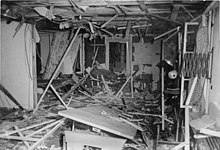A major historical dispute concerns Hitler's reasons for Operation Barbarossa. Some historians such as Andreas Hillgruber have argued that Barbarossa was merely one "stage" of Hitler's Stufenplan (stage by stage plan) for world conquest, which Hillgruber believed that Hitler had formulated in the 1920s.[268] Other historians such as John Lukacs have contended that Hitler never had a stufenplan, and that the invasion of the Soviet Union was an ad hoc move on the part of Hitler due to Britain's refusal to surrender.[269] Lukacs has argued that the reason Hitler gave in private for Barbarossa, namely that Winston Churchill held out the hope that the Soviet Union might enter the war on the Allied side, and that the only way of forcing a British surrender was to eliminate that hope, was indeed Hitler's real reason for Barbarossa.[270] In Lukacs's perspective, Barbarossa was thus primarily an anti-British move on the part of Hitler intended to force Britain to sue for peace by destroying her only hope of victory rather than an anti-Soviet move. Klaus Hildebrand has maintained that Stalin and Hitler were independently planning to attack each other in 1941.[271] Hildebrand has claimed that the news in the spring of 1941 of Soviet troop concentrations on the border led to Hitler engaging in a flucht nach vorn ("flight forward" – i.e. responding to a danger by charging on rather than retreating.)[271] A third faction comprising a diverse group such as Viktor Suvorov, Ernst Topitsch, Joachim Hoffmann, Ernst Nolte, and David Irving have argued that the official reason given by the Germans for Barbarossa in 1941 was the real reason, namely that Barbarossa was a "preventive war" forced on Hitler to avert an impeding Soviet attack scheduled for July 1941. This theory has been widely attacked as erroneous; the American historian Gerhard Weinberg once compared the advocates of the preventive war theory to believers in "fairy tales"[272]
The Nazi invasion of the Soviet Union reached its apex on 2 December 1941 as part of the 258th Infantry Division advanced to within 15 miles (24 km) of Moscow, close enough to see the spires of the Kremlin,[273] but they were not prepared for the harsh conditions brought on by the first blizzards of winter and in the days that followed, Soviet forces drove them back over 320 kilometres (200 miles).
On 7 December 1941, Japan attacked Pearl Harbor, Hawaii, and four days later, Hitler's formal declaration of war against the United States officially engaged him in war against a coalition that included the world's largest empire (the British Empire), the world's greatest industrial and financial power (the United States), and the world's largest army (the Soviet Union).
On 18 December 1941, the appointment book of the Reichsführer-SS Heinrich Himmler shows he met with Hitler, and in response to Himmler's question "What to do with the Jews of Russia?", Hitler's response was recorded as "als Partisanen auszurotten" ("exterminate them as partisans").[274] The Israeli historian Yehuda Bauer has commented that the remark is probably as close as historians will ever get to a definitive order from Hitler for the genocide carried out during the Holocaust.[274]

Adolf Hitler in Reichstag during his speech against Franklin D. Roosevelt. 11 December 1941.
Following the allied invasion of Sicily (Operation Husky) in 1943, Mussolini was deposed by Pietro Badoglio, who surrendered to the Allies. Throughout 1943 and 1944, the Soviet Union steadily forced Hitler's armies into retreat along the Eastern Front. On 6 June 1944, the Western Allied armies landed in northern France in what was one of the largest amphibious operations in history, Operation Overlord. Realists in the German army knew defeat was inevitable, and some plotted to remove Hitler from power.

0 comments:
Post a Comment